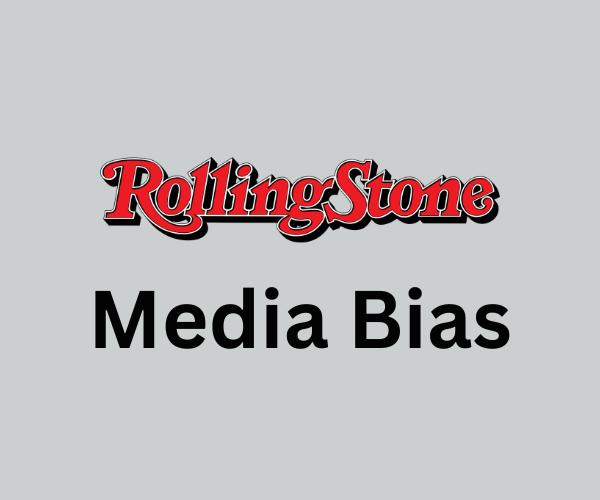
The Rolling Stone news company was originally founded in 1967 in California and is now based in New York City, NY. With a history of focusing on music, it has since expanded considerably to cover pop culture, entertainment, humor, as well as politics and social issues. There is also a renowned photography section featured on its website. Rolling Stone has published several award winning investigative reports and has released numerous international editions. Most reports on the source agree that it has a largely liberal audience and supports a left-leaning ideology. We will analyze the Stone’s coverage to determine the bias included in current articles and alert readers to potential partiality so that they can better distinguish fact from opinion.
How Does Biasly Rate News Sources?
Biasly’s algorithms produce bias ratings to help provide multiple perspectives on given articles. Biasly has analyzed 200,000+ news articles from more than 3,200 news sources through our A.I. technology and team of political analysts to find the most factual, unbiased news stories.
Biasly determines the degree of political bias in news sources by using Biasly’s Bias Meter Rating, in which Biasly’s team analyzes media sources’ reliability and bias and produces three scores, a Reliability Score that measures the accuracy of media sources; an A.I. Bias Score, evaluated by A.I.; and an Analyst Bias Score evaluated by political analysts. These scores are rated based on seven rating metrics including Tone, Tendency, Diction, Author Check, Selection/Omission, Expediency Bias, and Accuracy. These metrics help our analysts to determine the political attitude of the article.
Our A.I. machine-learning system employs natural language processing and entity-specific sentiment analysis to examine individual articles and determine their bias levels. By analyzing the key terms in an article such as policies, bias phrases, political terminologies, politicians, and their nicknames, the algorithms can rate the attitude of the text. Bias scores range from -100% and 100%, with higher negative scores being more liberal and higher positive scores being more conservative, and 0% being neutral.
Is the Rolling Stone Politically Biased?
Biasly’s rating for Rolling Stone is based on two scores. The first is from computer algorithms based on A.I. technology, and the second is based on conclusions from trained analysts. Rolling Stone is given a Computer Bias Score and Analyst Bias Score of “Medium Liberal,” which means that the source is likely to promote left-leaning ideas in its reports. An average of fifteen articles was reviewed to reach this conclusion, with at least one liberal, moderate, and conservative analyst included. The score will become increasingly precise as more articles are read and analyzed. The general content found on the website confirms this rating, in our opinion.
Many other news sources, such as The Guardian, Wall Street Journal, and The Washington Post have also found the Rolling Stone to lean left. This is important to note as these sources tend to support Democratic ideals as well. In 2022, an opinion piece from the Wall Street Journal stated:
“Rolling Stone has a history of making reckless and defamatory accusations in furtherance of a political agenda.”
Opinions of the source will vary based on the political stance of the reader. As such, how much liberal bias is truly found in their coverage? This article will continue to investigate possible bias.
Before we begin, we need to discuss bias. Bias is a natural function of humans, and we can express it both consciously and unconsciously. Bias is one of the most fundamental forms of pattern recognition in humans. This isn’t to lower the bar and say that “all things are biased,” but to explain the process in which we may come to trust certain news organizations that display patterns of coverage.
On the media’s part, there is an incentive to retain audiences, encourage them to purchase subscriptions, and rate products positively. Bias is a two-way street, people want to see news stories about things they care about, and the media needs viewers to continue their operations. This creates a positive feedback loop that influences what stories are covered and from what perspective. This also explains the actions of more liberal news organizations.
Analysis of Bias in Rolling Stone’s Online Articles
Similarweb finds that over half the traffic on Rolling Stone’s website comes from the United States, with the next highest percentage of consumers (though substantially smaller) coming from Canada, the United Kingdom, and Australia. The majority of readers are between the ages of 25 and 34, followed by those ages 35 and 44. It is necessary to consider: Does the significant viewership from young members of the United States influence the politics found throughout the Stone’s articles?
The most common metrics utilized when determining bias are, tone, diction, tendency, author, and expediency bias. Tone refers to the attitude expressed by an author in their articles and is typically related to diction, or the words chosen to express the writer’s ideas on a particular subject. Tendency is the consistency in which an author upholds a specific tone, or shows bias in their work. The author category examines a writer’s history, specifically through past articles and social media posts, to discern a political inclination. Lastly, expediency bias is the initial impression purported by an article’s title, subheading, or opening image. These metrics must all be examined in tandem to appropriately establish the type and frequency of bias.
The first article we will observe is “Nikki Haley Called Trump ‘Unstable and unhinged.’ Now She’s Voting for Him,” by Jeremy Childs.The piece explains ex-presidential candidate Haley’s reasoning behind supporting candidate Trump in the 2024 election but includes liberal bias. For example, it begins:
“Nikki Haley spent the 2024 primary season railing against Donald Trump, but now she’s pledging her vote to him, tail between her legs.”
The tone, while not as blatantly harsh throughout the rest of the article (establishing a less significant tendency), still contains left-leaning attitudes. Diction is used to portray certain emotions and images, such as with language like “tail between her legs.”
“Haley has made her feelings on Trump well known while campaigning against him, calling him ‘unhinged and unstable.’ She had fashioned herself as a candidate for Republicans who disdained Trump but feared expressing that opinion publicly due to his fervent voter base.”
We can again see how the diction chosen does not express positive opinions of Nikki Haley. Phrases such as “[Haley] feared expressing that opinion” creates a fragile image of the politician.
The second article we will look at is “Mike Johnson Insists He’s Not Resigning as Second Republican Moves to Oust Him,” by Nikki Mccann Ramirez. The author discusses the Motion To Vacate Effort directed toward Speaker Mike Johnson, specifically referencing the attempts by Republican Representatives Marjorie Taylor Greene and Thomas Massie. This report is rated by Biasly as “Extremely Liberal,” which is seen primarily through its use of diction against the right side of the political spectrum.
“Republicans — humiliated by chaos and public displays of incompetence in the aftermath of former Speaker Kevin McCarthy’s ouster — are deeply skeptical of Greene’s move against Johnson.”
Words such as “humiliated” and “incompetence” display bias against Republican officials. The tone is highly critical of Johnson, including opinions from other Republican officials who disagree with his decisions. While several Republican officials are referenced, the article does not include perspectives from those who support Johnson or his actions. The tendency is consistent, offering an account of the Motion but lacking balanced perspectives. The author’s political bias can be seen through her social media, specifically her posts and reposts on the X platform. For example, this repost with a negative representation of Greene:
Marjorie Taylor Greene is genuinely unraveling like never before
Here she is ranting about Fox News not covering her stunts, blaming it on the firing of Tucker Carlson, who she says the network “would love to murder”
https://t.co/GE9IQIwOBJ pic.twitter.com/ivjdYiywJi
— Madeline Peltz (@peltzmadeline) May 10, 2024
Below is another example about former President Trump:
Trump has pushed a slew of terrifying proposals, both publicly and privately, that he plans to unleash on America should he take down Biden.
More: https://t.co/Rb31xQHFq8 pic.twitter.com/dtdWbjLRo1
— Rolling Stone (@RollingStone) April 30, 2024
Examples of expediency bias are readily available on Rolling Stone’s webpage. Titles such as “Trump Says He’d ‘Immediately Deport “Anti-Americanism”’ Protestors in Bizarre Rally Speech,” “Chiefs Kicker Spreads Antisemitic Lies in Benedictine College Graduation Speech,” “Doctors Plead With Lawmakers Not to Criminalize Life-Saving Pregnancy Care Pills,” and so forth, evoke powerful emotions and serve to progress a liberal agenda. The tone throughout these three articles, in particular, confirms this bias and highlights criticisms against Republican values. There are also unflattering images of Republican officials used to capture attention for certain articles, such as displayed in “The Boos Have It. Trump Ruled Ineligible for Libertarian Nomination,” by Peter Wade. Many unfavorable pictures and headlines/subheadings are associated with the 2024 Republican presidential candidate Donald Trump, in particular, such as the below:

Source: Rolling Stone
Analysis of Rolling Stone Opinion Articles
Opinion articles and reports must be distinguished before observing further pieces by Rolling Stone. Reports are designed to be unbiased, factual accounts of an event using primary sources and quotes, whereas opinions represent and often promote an author’s personal views on a subject. Rolling Stone articles include many details on current events but also incorporate a considerable amount of subjectivity. Readers must be cautious that many authors on the site infuse their own opinion into the pieces they write.
The first article we will examine is “Alabama’s War on Women,” by Tessa Stuart. This piece seeks to educate readers on various rulings regarding abortion, IVF, and child endangerment, with a specific focus on the state of Alabama. While it thoroughly describes recent legal proceedings, it strongly emphasizes a pro-choice opinion. This can be seen through quotes, proposed as facts, such as the following:
“Experts have long warned that elevating an embryo’s legal status effectively strips the person whose body that embryo occupies of her own rights the moment she becomes pregnant.”
The author uses diction that undermines pro-life ideas, and the tone of the article is significantly one-sided. The article is not distinctly classified as an opinion piece on the Rolling Stone’s website, but its content makes it clear that it includes sentiments that are not completely accurate.
The next piece, “Are there Insurrectionist Supporters on the Supreme Court?” by Jay Michaelson, is labeled as commentary by the Rolling Stone. The article serves largely to condemn Supreme Court Justices Alito and Thomas.
“This is the country we live in: a country in which Justice Samuel Alito — a man with massive power over all our lives, who wrote the court opinion overturning Roe v. Wade — can engage in overtly anti-democratic activity, and the only response is a few angry opinion pieces in newspapers and some gentle chiding from lawmakers”
The tone throughout the article consistently paints conservative officials in a negative light. The diction also supports a left-leaning agenda, which can be seen in the previous quote through phrasing such as “overly anti-democratic activity.” The article, while rated “Center” by Biasly’s News Check Chrome Extension, tends to underline liberal objectives.
Who Owns the Rolling Stone?
The Rolling Stone magazine is owned by the Penske Media Corporation, which purchased a major stake in the company from Wenner Media in 2017 and the remaining percentage from BandLab Technologies in 2020. Penske Media is based in Los Angeles and New York City and owns over twenty print and digital organizations. The company receives its name from founder and CEO Jay Penske, who established the business in 2004. He recently joined the board for Vox Media, rated by Biasly as “Very Liberal,” in 2023.
Rolling Stone’s previous editor-in-chief was Noah Shachtman, who has an extensive and impressive history with journalism. He has contributed to The New York Times, The Wall Street Journal, The Washington Post, Slate, and other popular companies. It is worth mentioning that he also served as a campaign staffer in Bill Clinton’s 1992 presidential campaign. The editor before Shachtman, Jann Wenner, made political donations to Democrats. Rolling Stone, as an organization, endorsed Democratic candidate Hillary Clinton in the 2016 presidential election. This is important because it establishes a pattern of the media source and its employees supporting liberal ideologies.

Noah Shachtman (2022), Source: Wikipedia
How to Evaluate and Uncover Bias
It can often be difficult to tell if the news you watch is biased. If you have settled on a news channel, it’s usually because you trust the information you are gaining. Unfortunately, many trust the information they are hearing because it confirms what they already believe. This is referred to as “confirmation bias.” It is important to challenge your beliefs and get third-party verification that what you are hearing is the full story. This is why we recommend using Biasly to compare different news stories side-by-side using our bias ratings to figure out what both sides think of a political issue.
To reiterate, Biasly rates the Rolling Stone source as “Medium Liberal,” because of its tendency to promote liberal and neglect conservative viewpoints. Readers must be aware of any potential bias when reading articles from this company and consider cases of subjectivity. Levels of bias will not be the same in every piece, so viewers should also reference the rating metrics described previously. To aid in distinguishing fact from opinion, individuals can use Biasly’s News Bias and Reliability Checker.


























